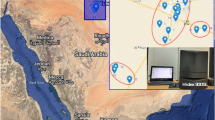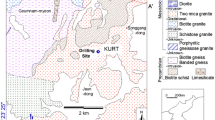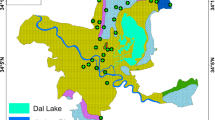Abstract
A simple method for the determination of the air–water partition coefficient (Kair/water) of radon (Rn-222) was studied using a liquid scintillation counter. In the present work, the radon activity of groundwater phase in a closed container was measured and used to calculate the partition coefficient instead of the radon activity of gaseous phase in other works. The partition coefficient was determined for four groundwater samples by using a modified equilibrium partition coefficient in closed system method. The effect of temperature on the partition coefficient was investigated at 0, 10, 20 and 30 °C. Within the temperature range, the partition coefficients were 1.72–2.03, 2.11–2.28, 2.78–3.92 and 4.93–5.61 at 0, 10, 20, and 30 °C, respectively. It was found that the effect of temperature on the air–water partition coefficient of groundwater radon was agreed well with literature values.
Similar content being viewed by others
Explore related subjects
Discover the latest articles, news and stories from top researchers in related subjects.Avoid common mistakes on your manuscript.
Introduction
Emanation of radon and its entry into buildings have been of serious concern to public health over the last decades. Exposure to radon gas is one of the greatest health concerns related to naturally occurring radioactivity [1]. The principal health hazard associated with radon is due its short-lived daughter products [2]. The Environmental Protection Agency (EPA) has estimated that 20,000 lung cancer deaths per year may be related to radon exposure [3]. Overall, as a global average, at least 80% of the radon emitted into the atmosphere comes from the top layer of ground [4]. The second most important contributor to outdoor radon is emanation from groundwater sources. The concentration of radon in groundwater or well water depends strongly on the character of the host rock. Because of the solubility of radon in water, very high levels of radon can occur even at the hot water [5]. Groundwater is one of the main sources of indoor radon. When radon containing groundwater was used for domestic purpose, the radon can be released into living space. Inhalation of indoor radon leads to deposition of its decay products such as Po-218, Po-214 on the walls of the lung, especially in the bronchial region. In the decay of these atoms, alpha particles are emitted which irradiate the cells of the lung tissue through which they pass. These irradiated cells may become cancerous. The adverse health effects of groundwater radon are largely due to the transfer of radon to indoor air, where it decays and its short lived radioactive daughters inhaled, rather than from direct ingestion. Thus it is important to know the contribution which radon in groundwater of a given building makes to the radon concentration in indoor air [6].
The partition coefficient relating air and aqueous concentrations of a volatile substance is commonly referred to as Henry’s law constant (H) [7]. In general, H is a ratio of vapor pressure and solubility in a vapor–liquid equilibrium state at a certain temperature. H is usually expressed as a dimensionless form and also called an air–liquid partition coefficient in the environmental literature: H = Ca/Cl, where Ca and Cl are the gas- and aqueous-phase concentrations (mg/L) of volatile organic compound (VOC), respectively [8]. Additionally, air- water partition coefficient of radon in groundwater allow for its use as naturally occurring aqueous tracers. Respective approaches have been described for several fields of hydrology [9–14]. Several methods are applied to study the air–water partitioning [15]. Radon partition coefficients are well known for a wide range of pure substances, few reliable data is available on radon partitioning into complex materials like groundwater having various impurities.
In the present work, a modified equilibrium partitioning in closed system (mEPICS) [7, 8, 16, 17] was improved to estimate radon partitioning between groundwater and atmosphere by a LSC (ultra-low-background Wallac 1220 Quantulus™, Perkin Elmer Co.). To evaluate improved method, four groundwater samples having high radon activity were examined at 0, 10, 20, and 30 °C. And then the relationship between temperature and the coefficient was compared with literature values.
Experimental
Groundwater samples were taken from four groundwater facilities having high radon activity. 8 mL of each groundwater sample was transferred into 22 mL counting vial having 12 mL of cocktail solution (Optiphase Hisafe 3) to measure the activity of radon by the LSC. Each of the groundwater was sampled into two 1 L high density polyethylene bottles without headspace. One bottle was stored at 4 °C in a refrigerator before use. Another was transferred into 2 L of glass beaker and boiled for 30 min followed by purged with argon gas for 10 min with 300 mL/min flow rate. By the boiling and purging treatments, more than 95% of radon was removed from the groundwater. Activity of Rn-222 in the groundwater was measured by the LSC. Activity of radon in groundwater were 10,800 pCi/L for groundwater 1 (GW1), 4,700 pCi/L for groundwater 2 (GW2), 5,600 pCi/L for groundwater 3 (GW3) and 8,500 pCi/L for groundwater 4 (GW4).
For each groundwater, eight 125 mL serum bottles were used. Four serum bottles contained 10 mL of boiled groundwater and 10 mL of untreated groundwater, the other four serum bottles contained 50 mL of boiled groundwater and 10 mL of untreated groundwater. The bottle was sealed with silicon septum and aluminum crimp cap. The serum bottles were then incubated for 24 h at each of the temperatures (0, 10, 20, and 30 °C). The bottles were in inverted position on bottle rack to prevent the leakage of radon through the septa. At the end of the incubation, 8 mL of groundwater phase was sampled from the bottles and transferred into the counting vial containing 12 mL of cocktail solution. Groundwater phase transferred and the volume of serum bottle was determined gravimetrically. The counting vial was shaken for 3 h in upside down position to dissolve radon into the cocktail solution and to equilibrate between Rn-222 and its progenies. The radon activity concentration was then measured by the LSC.
Results and discussion
Air–water partition coefficient of groundwater radon
Several methods are applied to study the air–water partitioning. In the EPICS-method two bottles, into which an equal mass of VOC is added, but different gas water volume ratio, are incubated. The air–water partition coefficient is calculated from measurement of the headspace concentration ratio [7, 16]. The original EPICS procedure is based upon the addition of equal masses of a volatile solute to two sealed serum bottles that are identical in all respects except one: they possess differing groundwater volumes. The limiting precision was said to be that associated with attempted delivery of equal solute masses to the bottle pairs. The original EPICS formulation is modified in an attempt to improve precision by Gossett [7]. In essence, the assumption of equal solute masses in the individual bottles comprising an EPICS system is eliminated. Instead, differences in mass due to imperfect, volumetric additions are accounted for through gravimetric means. Several authors used this modified EPICS (mEPICS) in measuring Henry’s law constant (H) for various VOCs [8, 16, 17]. Headspace concentration of VOC was used for estimation of the H in their work.
In the present work, radon activity of groundwater phase, instead of that of gaseous phase was used to calculate the air–water partition coefficient (Kair/water) of groundwater radon. The total activity (Bq) of Rn-222 (M) transferred into a serum bottle will be partitioned at equilibrium according to
where Cw and Cg are radon activity (Bq/L) in groundwater and gaseous phases, respectively. Vw and Vg are the volume of groundwater and gaseous phases in the serum bottle (L). Kair/water is the air–water partition coefficient of radon (Kair/water = Cg/Cw, dimensionless). If two bottles are prepared with differing groundwater volumes, Vw1 and Vw2 then Eq. 1 will hold for each, and we may write
By dividing Eq. 2 by M1 and Eq. 3 by M2 and if
then obtains for Kair/water
Knowing the volumes (L) Vw1, Vw2, Vg1, Vg2 and the total activities (Bq) of the radon M1, M2 by weighing the transferred groundwater and by measuring the activity (Bq/L) of radon in groundwater phase, Kair/water can be calculated using the ratio of Cw1 and Cw2 instead of the absolute radon activity. The overall error of Cw was 6.1 ± 1.7%. In most physical and chemical experiments, gravimetric measure is more precise than volumetric measure. Additionally, groundwater phase was measured to calculate Kair/water in this study, instead of gaseous phase in the numerous studies. Table 1 shows radon partition coefficient between groundwater and atmosphere at 0–30 °C.
Effect of temperature on air–water partitioning of groundwater radon
The partitioning of radon between air and water is a function of temperature. The temperature dependence of air–water partitioning of radon has been well modeled with the following equation [1]
where T is the temperature in °C. With increasing temperatures the quantity of radon soluble in water decrease, i.e. the partition coefficient raises. Fig. 1 illustrates the influence of the temperature on the partition coefficient of the radon of groundwater with that of distilled water calculated by Eq. 6. As can be seen, Kair/water increases exponentially with increasing temperature. The results are agreed well with the reference value [1, 15] for distilled water.
The effect of the temperature on the air–water partition coefficient of the groundwater radon and the distilled water [1]
Conclusions
A further development of the EPICS method in order to measure air–water portion coefficient (Kair/water) of groundwater radon was conducted by using a liquid scintillation counting method. Activity of radon in groundwater phase instead of gaseous phase was used to estimate the coefficient of groundwater radon. The temperature relationship upon the coefficient of groundwater radon was well agreed with literature value. The results show that air–water partitioning coefficient of groundwater radon can be simply calculated using the activity ratio between two serum bottles instead of the absolute radon activity.
References
Kiiari T, Pashalidis I (2008) Radiat Meas 43:1463–1466
Berger RS (1990) Environ Sci Technol 24:30–31
Schmidt A (1992) J Radioanal Nucl Chem 161:283–291
NCRP (National Council on Radiation Protection and Measurements) (1984b) NCRP report No. 78 (Bethesda, MD:NCRP)
Bodansky D, Breysse PA, Geraci JP, Jackson KL, Nevissi NA, Robkin MA (1987) Bodansky D, Robkin MA, Stadler DR (eds) University of Washington Press. 42–49
ibid. 51–63
Gossett JM (1987) Environ Sci Technol 21:202–208
Robbins GA, Wang S, Stuart JD (1993) Anal Chem 65:3113–3118
Prasad Y, Prasad G, Gusain GS, Choubey VM, Ramola RC (2009) Indian J Phys 83:1001–1010
Schubert M, Paschke A, Lau S, Geyer W, Kno¨ ller K (2007) Environ Pollut 145:920–927
Schubert M, Lehmann K, Paschke A (2007) Sci Total Environ 376:306–316
Burnett WC, Dulaiova H (2003) J Environ Radioact 69:21–35
Burnett WC, Kim G, Lane-Smith D (2001) J Radioanal Nucl Chem 249:167–172
Davies BM, Istok JD, Semprini L (2002) J Contam Hydrol 58:129–146
Lee KY, Yoon YY, Ko KS (2010) J Radioanal Nucl Chem. doi:10.1007/s10967-011-1306-5
Dewulf J, Drijvers D, Van Langenhove H (1995) Atmos Environ 29:323–331
Kucklick JR, Hinckley DA, Bidleman TF (1991) Mar Chem 34:197–209
Acknowledgements
This research was supported by the Basic Research Project of the Korea Institute of Geoscience and Mineral Resources (KIGAM) funded by the Ministry of Knowledge Economy of Korea.
Author information
Authors and Affiliations
Corresponding author
Rights and permissions
About this article
Cite this article
Lee, K.Y., Yoon, Y.Y., Cho, S.Y. et al. Determination of radon partitioning between groundwater and atmosphere by liquid scintillation counter. J Radioanal Nucl Chem 294, 27–30 (2012). https://doi.org/10.1007/s10967-011-1608-7
Received:
Published:
Issue Date:
DOI: https://doi.org/10.1007/s10967-011-1608-7





